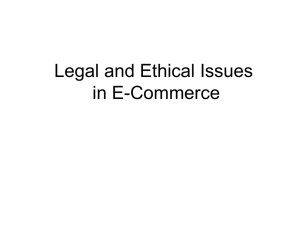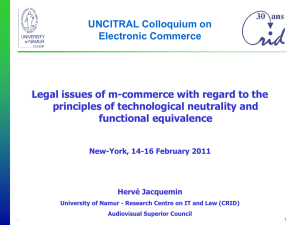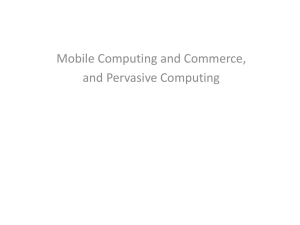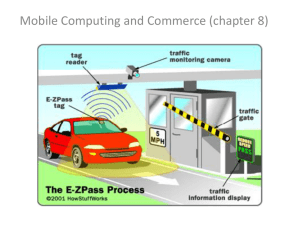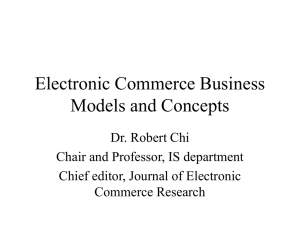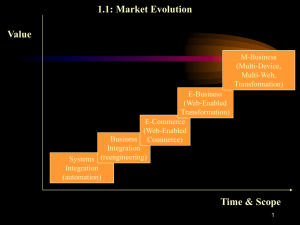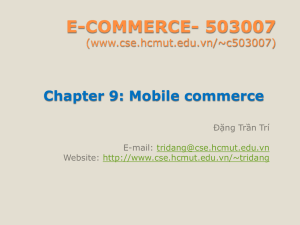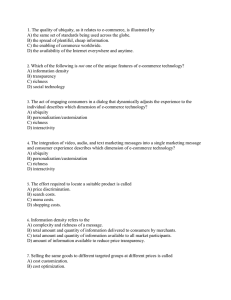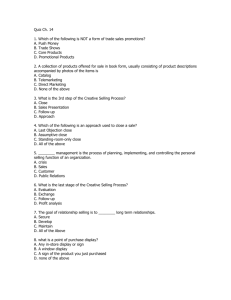E-COMMERCE AND DEVELOPMENT REPORT 2002
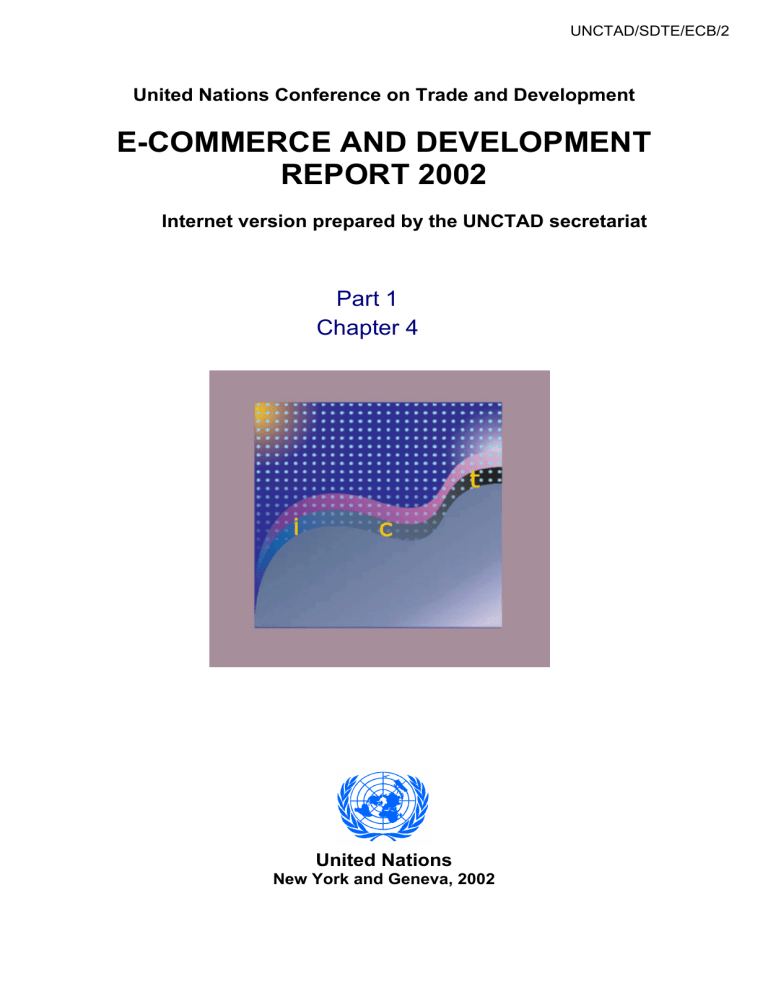
UNCTAD/SDTE/ECB/2
United Nations Conference on Trade and Development
E-COMMERCE AND DEVELOPMENT
REPORT 2002
Internet version prepared by the UNCTAD secretariat
Part 1
Chapter 4
United Nations
New York and Geneva, 2002
Note
Symbols of United Nations documents are composed of capital letters with figures. Mention of such a symbol indicates a reference to a United Nations document.
The designations employed and the presentation of the material in this publication do not imply the expression of any opinion whatsoever on the part of the Secretariat of the United Nations concerning the legal status of any country, territory, city or area, or of its authorities, or concerning the delimitation of its frontiers or boundaries.
Material in this publication may be freely quoted or reprinted but acknowledgement is requested, together with a reference to the document number. A copy of the publication containing the quotation or reprint should be sent to the UNCTAD secretariat.
The Executive Summary of this Report can also be found on the Internet at the following address: http://www.unctad.org/ecommerce/
UNCTAD/SDTE/ECB/2
Copyright © 2002, United Nations
All rights reserved
Chapter 4
M-COMMERCE: W IRELESS COMMUNICATIONS
OPPORTUNITIES FOR DEVELOPING COUNTRIES
A.
Introduction
This chapter examines m-commerce , a new form of electronic commerce brought about by the rapid growth of wireless communications.
The most common definition of m-commerce is the buying and selling of goods and services using wireless handheld devices such as mobile telephones or personal data assistants (PDAs). A broader definition that extends m-commerce to “mobile business” may be more appropriate. This involves business-related communication among individuals and companies where financial transactions do not necessarily occur.
In the last four years, the growth in the number of mobile telephone users worldwide has exceeded the growth in the number of fixed lines, expanding from
50 million to almost one billion in 2002. Today, over 90 per cent of countries have a mobile network, and nearly one in every six of the world’s inhabitants has a mobile telephone. Almost 100 countries have more mobile than fixed-line telephone subscribers and this will become a global phenomenon in the early part of
2002.
1 The introduction of wireless communications has not only expanded telephony in many developing countries, but also introduced wireless data services which are essential for conducting m-commerce. For many people in developing countries, mobile handsets may be the first and main access route to information and commumcation technologies (ICT), the Internet and e-commerce technologies.
The challenge is to provide access to the global telecommunications system for a significant number of citizens in developing countries. Mobile communications may be the technology that overcomes the barriers constituted by the high cost of installing fixed-line infrastructure that developing countries continue to encounter.
2
The many facets of m-commerce, encompassing a number of dynamic and evolving services, will be examined in this chapter. It begins with a description of the main features of m-commerce. Experiences in several countries are discussed where relevant. Current m-commerce applications and trends, including banking and insurance, logistics, securities, and information services, are also reviewed. In addition, regulatory issues related to data security and privacy are assessed. Finally, the main findings and recommendations for developing country m-commerce readiness are presented.
B.
Main features of m-commerce
Wireless communications provide the long sought after platform that can make digital data transfer possible in many developing countries. This is due in part to the lower costs of mobile systems relative to fixed networks, the provision of short message services
(SMS) and the enabling of wireless Internet connections. In developing countries most mobile services are prepaid using stored value cards. This mitigates post-paid subscription problems of creditworthiness and billing.
By mid-2002 there were 300 million mobile telephone users in the Asia-Pacific region. China has the largest number of mobile telephone users in the world: more than 170 million in mid-2002, with over 400 million forecast by 2005 − 2006.
3 Europe is an important mobile market with over 300 million subscribers forecast for 2002. The number of wireless communications has already exceeded the number of fixed-line subscribers, and it is expected that in many countries, particularly developing countries, telecommunications operators will continue to rapidly increase the number of mobile subscribers thanks to low infrastructure and operating costs. Surveys in the United States indicate that wireless services are expected to be a major vehicle for customer relationship management (CRM) and that the amount of business management and marketing activities carried out using remote communications is continuously growing.
4
M-commerce represents the extension of e-commerce to a mobile environment. The main types of e-com-
90 CHAPTER 4: M-COMMERCE merce – B2B, B2C, B2G and P2P–- remain. In developing countries mobile business applications, especially when used by small and medium-sized enterprises in remote areas, may become a key method for reaching potential customers, and are expected to be highly important features of m-commerce.
• Data portability.
Users can store profiles of products, company addresses, information about restaurants and hotels, banking details, payment and credit card details, and security information, and access these when needed for purchases or for making contact, all from their mobile handsets.
In 2002 worldwide m-commerce revenues are forecast to be just below $50 billion. The United States and
Western Europe will dominate actual and forecast revenues through 2005. But by 2005 sales generated in the
Asia-Pacific region and the rest of the world are expected to register a significant increase, approaching
40 per cent of the global $225 billion m-commerce revenues forecast. Given that global revenues in 2001 were about $20 billion and very small in regions outside North America and Europe, it is difficult to determine what the major m-commerce transactions have been. Most m-commerce is B2C where micro-purchases are involved. Larger transactions continue to be conducted using the usual e-commerce methods.
5
The surge in mobile handset use throughout the world, the dramatic growth of the Internet, and the proliferation of PDA (personal data assistants) are expanding the e-commerce market in which m-commerce is expected to flourish.
6 A number of unique advantages of m-commerce have been identified:
Internet use has been dependent on personal computers (PCs) and a fixed-line network. And the growth of the Internet drives e-commerce. Consequently, until the advent of mobile telephone, e-commerce has been dependent on expensive infrastructure and equipment. Today, however, there is a growing convergence of the Internet and mobile communication. Handsets are acquiring functionalities that were limited to desktop PCs only a few years ago. Many are already running slimmed-down versions of PC operating systems and applications, and the difference between future handheld and desktop devices is likely to be related to the ergonomics of the physical user interface that will be designed to serve a particular purpose, rather than lack of processing power, memory or network accessibility.
•
•
•
Immediacy.
Consumers are constantly moving, working, commuting, travelling, socializing and shopping. M-commerce lets them buy goods and services as soon as the need arises.
Connectivity.
interest can be instantly connected via text messaging and mobile chat capabilities. Advertisers can use such access to promote products and make special offers with the expectation that subscribers will answer and listen to their messages.
Localization.
Users sharing a common location or
With the deployment of positioning technologies, such as the global positioning system (GPS), companies can know users’ whereabouts and will be able to offer goods and services specific to their location.
The ITU reports that 225 countries and territories have dial-up Internet connections – that is, a link to the Internet through a local telephone line. In 2001 there were over 500 million Internet users, representing 8.2 per cent of the world’s population. Global distribution of Internet access, however, remains dominated by developed countries, where over half of the adult population is online 7 (see chapter 1 for a detailed analysis of the Internet population). Wireless access is likely to be the principal means of bringing more people in developing countries to the Internet. For that purpose, mobile networks and handsets need to be upgraded to carry data and messaging, as well as traditional voice services. The introduction of “third generation” (3G) and Internet-enabled handsets in North
America and Europe is imminent. For the rest of the world, second generation (2G and 2.5G) mobile capabilities have opened-up opportunities for narrow-band Internet access and SMS (see box 14 for standards definitions).
E-COMMERCE AND DEVELOPMENT REPORT 2002
CHAPTER 4: M-COMMERCE
Box 14
Network technologies
Mobile protocols can provide a continuously increasing array of services to users.
1 The introduction of mobile communications continues to be subject to competing technical solutions. In contrast with the gradual development of fixed line telephony, these technologies are being introduced almost concurrently, even within the same country.
2 The most advanced third generation (3G) is being introduced in developed countries, whereas second generation (2G) less powerful technology is being applied in many developing countries. The following transmission technologies are likely to co-exist for some time in the future.
2G is the present widespread standard and consists of several implementations. GSM (Global System for Mobile Communications) operates in the 900 MHz and the 1,800 MHz (1,900 in the United States) frequency bands and is the prevailing standard in Europe and most of the Asia-Pacific region. The popularity of GSM provides the critical mass making it possible to develop a large variety of innovative applications and services economically. Other 2G GSM type technologies include DAMPS and PDC. In the United States, Japan and China, CDMA is an important standard.
2.5G mobile technology has been developed to provide voice and data services in parallel in order to bring data services and Internet access to mobile handsets. It also has several implementations. GPRS (General Packet Radio Service) is a packet switched wireless protocol that offers instant access to data networks. It permits burst transmission speeds of up to 115 Kbit/s when it is completely rolled out. A real advantage of GPRS is that it provides “always on” connection
(i.e. continuous IP connectivity) between the mobile terminal and the network, while users only pay for data that are actually transmitted. GPRS networks are already operational in Europe and are being introduced in South-East Asia and other regions, for example South Africa. EDGE (Evolved Data GSM Environment), a more evolved protocol that offers data delivery rates of up to 384 Kbits, and GPRS are considered evolutionary steps on the path from 2G to 3G.
3G is the generic term for the formal standard IMT-2000 (International Mobile Telecommunications 2000) adopted by the ITU. The standard was devised in order to support the development of broadband wireless Internet access.
Rather than establishing a technical specification, the ITU set forth criteria that implementations had to meet in order to achieve an IMT-2000 classification. There are several implementations based on IMT-2000. CDMA2000 was developed by the Third Generation Partnership Project 2 (3GPP2) consisting of five telecommunications standards bodies:
ARIB and TTC in Japan, CWTS in China, TTA in the Republic of Korea and TIA in North America. CDMA Direct
Spread is also known as WCDM(UMTS) and WCDM (DoCoMo) in Japan. TD-SCDMA was proposed by China Wireless Telecommunication Standards group (CWTS) and approved by the ITU in 1999. The Chinese Academy of Telecommunications Technology, in cooperation with private sector partners, developed the technology. Multiple 3G licenses have been issued in Germany, Japan, the Republic of Korea, the United States, and the United Kingdom.
Wireless Local Area Networks (WLAN), while more m-business than m-commerce, are gaining ground. Avoiding laying cable and using fixed lines can be a great advantage in a vast number of situations, ranging from business conferencing to managing very large production or construction sites. 802.11b is a WLAN implementation that is designed to substitute for wired networking and allows users to move around in buildings and remain connected. Its range is about 50 meters indoors and 500 meters outdoors. Bandwidth is specified up to 11 Mbps and decreases with range.
The Bluetooth WLAN implementation allows mobile phones, computers, and personal digital assistants (PDAs) to interconnect easily with each other using a short-range wireless connection. It has a range of about 10 meters and a bandwidth of up to 3 Mbps.
3
1 See presentation of technologies being deployed in mobile communications, using example of China, Fan Xing, Cyber
Century Forum.
2 See m-commerce, van Rooyen L. (2001)
3 Definitions were sourced from Searchnetworking.techtarget.com Definitions and Technologydecisions.com, The
High Road and the Low Road, February 2002.
91
E-COMMERCE AND DEVELOPMENT REPORT 2002
92
The goal of 3G is to enable broadband mobile Internet and data services capability. After expensive 3G licences were auctioned, mostly in Europe, telecommunication companies accumulated large debts and as a result, mobile broadband infrastructure and 3G have yet to be introduced. Many telecom operators are questioning whether customers will take-up 3G as rapidly as originally expected. The launch of 3G services has not been as successful as first forecast because potential early adopters are reasonably satisfied with pre-3G service offerings, thereby reducing the attractiveness of 3G’s additional features. The situation is quite different for most developing countries. The first objective of governments and telecommunications authorities is to expand the number of subscribers for mobile telephone voice and short message services.
Upgrading to 2.5G or 3G is unlikely in the near future.
CHAPTER 4: M-COMMERCE
The extent of developing countries’ involvement in mcommerce is dependent on the access and connectivity of the population to wireless communications. Providing millions of citizens in developing countries with access to wireless voice communications coupled with text messaging, and with an eventual upgrade to the
Internet, is crucial to building m-commerce markets in those countries. Engaging in m-commerce, however, requires more than mobile empowerment. Initiating purchases and completing payments remains a bottleneck for m-commerce in many if not most developing countries.
9 Unless selection, ordering, payment and delivery can be managed at costs that are lower than in traditional commerce, both e- and m-commerce may face serious problems.
The burning question for companies that have grown dependent on the Internet as a business vehicle is whether mobile telephony will result more in B2C applications than in B2B applications. It is impossible on the basis of existing experience to extrapolate what will happen in the years ahead. As regards B2B, there is little evidence that companies will change their purchasing practices because of m-commerce. The shortterm potential for e-commerce growth resides with the one billion mobile telephone users, who could supplement existing B2C e-commerce with m-commerce. There is rapid growth in micropayments for small items and information services. The key to increasing traditional B2C purchases such as banking transactions and to trading in securities through mcommerce is the implementation of payment systems that are low-cost and customer-friendly
C. W ireless in developing countries
The take-up of wireless has made progress even in relatively low-income areas, confirming yet again that communication is an essential human need. Prepaid cards allow access for people who would not qualify for a paid subscription. Mobile telephony is also helping to eliminate the seemingly endless waiting for a fixed-line subscription. With a mobile network, consumers can simply buy a handset togethere with a prepaid card and start using it as soon as the first base stations are in place. As mobile networks are often set up by private sector companies, the investment burden can shift away from the State.
8
This may no longer be the case when m-commerce is fully utilized. Because PCs are not required, and fixed-line subscriber fees do not have to be paid, the cost of m-commerce can be relatively low. A handset may cost less than $100 and prepaid cards have become dominant. An important mobile application that can be used for commercial activities is SMS, particularly because it can exploit the existing wireless infrastructure in many developing countries. However, if there is to be true m-commerce, mobile phones must be Internet-enabled.
Mobile telephony has been taken up to a considerable extent in Asia. There are currently more than 200 million handsets in use, of which more than 120 million are enabled to use data services.
10
In Asia there is much more involvement in m-commerce. The most developed countries in the region – Japan and the
Republic of Korea – have large mobile telephone populations with millions of Internet-enabled terminals.
The leading developing country example of m-commerce deployment in the region is China.
11 This is not only because the country now has 170 million mobile telephone subscribers, but also because SMS has become very popular and has created a vast potential for m-commerce applications. A detailed discussion of m-commerce developments and strategies in China is presented in annex 1.
Latin America has seen a slower adoption of wireless.
Even so, growth expectations are high and the Inter
Market Group and Jupiter Research forecast that in
2005 there will be more than 50 million mobile Internet users in Latin America.
12
Africa has more than 20 million mobile telephone users. By the end of 2001, 28 African nations had more mobile than fixed subscribers.
13 The number of
E-COMMERCE AND DEVELOPMENT REPORT 2002
CHAPTER 4: M-COMMERCE mobile subscribers in 30 sub-Saharan Africa countries, not including South Africa, rose from zero in 1996 to
1.7 million in late 2001.
14 Because most new African mobile subscribers have no fixed line available and very few own or can access a PC, their handset becomes their only communication device. Consequently, there is likely to be a great interest in using mobile handsets for as many applications as possible.
In the least developed countries (LDCs), mobile technology is increasing telephone access in a surprisingly short space of time. Uganda is an example of how mobile telephony has radically transformed access to communications in an LDC over a short period. As a result of the liberalization of the telecommunication sector and the low cost of installing wireless networks, the number of subscribers rose eight times from 1995 to 2000. Uganda’s mobile density ranking among
LDCs rose from 28th in 1997 to 8th in 2001 and today it has the third largest mobile network in the LDCs.
Uganda’s experience is being widely replicated in other
LDCs. By the end of 2001, 24 LDCs in Africa had more mobile than fixed-line subscribers. In many countries, this transition took a little over a year: more mobile telephone users were added to the national network during that period than during the entire period of fixed-line operations.
15
93 the greatest interest in m-commerce seems to be in
Italy whose large population of mobile telephone customers have indicated an interest in paying bills (56 per cent) and conducting banking transactions (60 per cent) via wireless devices. Mobile service providers allow both prepaid and post-paid account subscribers to register and link their cash/debit cards with mobile phone subscription accounts. This allows subscribers to conduct mobile transactions for services and goods offered through their particular mobile service provider, for example topping up of prepaid accounts and purchase of theatre tickets. Certain commercial activities using SMS, such as hotel and restaurant reservations, could eventually lead to a growth in m-commerce applications. The following discussion takes a more detailed look at several promising applications.
Since 1992 SMS has allowed people to send and receive text messages using their mobile phones. Each message can contain up to 160 alphanumeric characters. SMS is the backbone of m-commerce, with the number of messages totalling billions in 2001.
17 One of the greatest concentrations of SMS users is in Singapore, where 52 per cent of phone users utilize SMS more than once a day. SMS use in Australia, China and the Philippines is reported to be almost as high. The global average, however, is 23 per cent.
18
Another example is Afghanistan, where it is expected to take years to fully replace the infrastructures of electricity and fixed-line communications that have been destroyed. However, this is not the case with wireless communications: inhabitants of Kabul have obtained handsets and began using mobile services with prepaid cards in April 2002. By the end of May there were more than 2,000 handsets in use, a significant addition to the existing and inadequate 12,000 fixed lines.
16
D.
M-commerce applications and trends
Mobile telephone customers in many developed countries are starting to use handsets to make purchases from retail stores, conduct personal banking and make travel reservations, as well as to view sports and news programmes, and search the Web (see box 15). In Germany, for example, mobile users are said to “have a moderate attitude toward many new services”, yet about 25 per cent are particularly interested in m-commerce possibilities. In the United States mobile phones are often kept in family cars and used as auxiliary communication devices, rather than being carried and used continually by family members. In Europe,
1.
SMS
In December 2000, Filipinos were sending almost 50 million short messages a day, or around 9 per subscriber. The Philippines is the leader in per capita SMS usage, accounting for some 10 per cent of all short messages sent around the world. The Philippines had
8.5 million mobile telephone subscribers in June 2001.
The number of mobile telephones in use exceeded the number of fixed lines in 2000; it continues to grow rapidly and is expected to reach 15 to 20 million. SMS is said to offer a practical alternative for those who do not have a computer; mobile telephone subscribers outnumber PCs in the Philipinnes by 4 to 1. A mobile short message is actually much cheaper than a telephone call. SMS was initially free. A nominal 2 cents charge was introduced in 1999. SMS accounts for a growing portion of mobile telephone revenues, since for every call made on a mobile phone, an average of
10 short messages are sent. Wireless Application Protocol (WAP) remains expensive for B2C m-commerce applications. Finally, the vast majority of Filipinos still do not have credit cards to use for online transactions or may have insufficient bank account balances to tie a debit card to direct debit.
E-COMMERCE AND DEVELOPMENT REPORT 2002
94 CHAPTER 4: M-COMMERCE
Box 15
Survey of national B2C m-commerce market trends
Germany
• Germany has a relatively less receptive customer base. However, its sheer size within the European market makes it an important area.
• Mobile customers have moderate attitudes toward many new services. Much of current usage is personal calling by relatively light users.
• One quarter of German mobile phone owners would like to make purchases with their wireless devices, while over
30 per cent are interested in accessing video cameras at home and securing travel reservations.
Italy
• The Italian market is a high-potential area for m-commerce. The high penetration of mobile phones makes the customer base relatively large. Text messaging could capture more business.
• There is considerable interest in many mobile services: paying bills (56 per cent); paying for retail store purchases
(52 per cent); banking (60 per cent) and video-mail (66 per cent).
Japan
• Japan has the most receptive customer base for m-commerce.
• The recent success of new Internet-based entertainment services has heightened receptivity.
• Close to 30 per cent of mobile users want the same capabilities on their handset as on personal computers.
• There is substantial interest in advance mobile services: having a virtual tour guide (40 per cent); purchasing inexpensive items (34 per cent); viewing news and sports (33 per cent) and face-to-face video conversations (34 per cent).
Republic of Korea
• The Republic of Korea is a developing market that appears to be poised for rapid growth in the future.
• It has one of the largest penetrations of web-enabled phones (50 per cent of all handsets), which gives this market high growth potential for broadband applications.
• 41 per cent of mobile owners use their devices some or all of the time at home, 66 per cent of the time while at work or school, and 68 per cent of the time while on vacation.
• There is solid interest in advanced mobile services: viewing real-time traffic conditions (43 per cent); accessing maps or directions (55 per cent).
United Kingdom
• The UK is a mid-level market, where future growth will require that mobile services do a superior job of delivering on promised performance and value.
• Users in the UK tend to feel slightly overwhelmed by information, and that society has become too dependent on technology.
• At the same time, there is a strong interest in m-commerce with practical applications: having face-to-face video conversations (48 per cent) and locating ATMs (60 per cent).
United States
• The US market is bimodal, having a dichotomy between heavy and light mobile users.
• The United States is an essential target for any global mobile commerce business strategy.
• Mobile users split their time 75 per cent/25 per cent between personal and business use, while over half use devices in cars.
• Interest in advance services varies: receiving short bites of entertainment (15 per cent); accessing maps and directions (50 per cent); and viewing news and sports (23 per cent)
Source: Personal Communications Industry Association/Yankelovich Global m-User Market Research.
E-COMMERCE AND DEVELOPMENT REPORT 2002
CHAPTER 4: M-COMMERCE
In Hong Kong, China, wireless data traffic was underdeveloped because local mobile telecommunications operators were not eager to expand this business while revenue from voice traffic alone was growing rapidly.
In December 2001, six local mobile operators announced an agreement to make their SMS interoperable and forecast significant new revenue from SMS in the years ahead.
95
Saving time, simplicity and speed of payments are the main advantages of mobile settlements. The following characteristics are listed in order of importance:
• Payments;
• Rapid payment;
• Record of payment provided;
2.
M-commerce offers vast opportunities to make micropurchases easier.
United States.
3.
Micro-payments
Financial Services
stores.
21
19 These can be as simple as buying from a vending machine, paying a parking meter or purchasing gasoline. Among the most widespread mcommerce applications using SMS, is making payments through post-paid accounts linked to debit cards. In the case of subscriptions to information services, the mobile service provider charges the customer through monthly bills. However, in many developing countries a shortage of consumer credit systems and the lack of automated payment systems that can be conveniently used for wireless electronic payments are hampering advancement of m-commerce. Micro-payments and settlements via wireless are growing rapidly in a number of developed countries. Estimates for
2002 are typically around $1.5 billion.
20 Forecasts for wireless micro-payments speak of $ 200 billion worldwide by 2005, with more than $ 40 billion in the
A wide variety of mobile payment and settlement methods are currently used in various countries. In the
Republic of Korea, mobile Internet customers prefer to integrate charges for purchases into their monthly telephone bills. Japanese often prefer to pay mobile
Internet charges and usage fees in cash at convenience
Prepaid value cards are widely used in Japan. However, a growing number of services, such as specialized information services, can be charged to monthly telephone bills. A new system will be introduced before the end of 2002 that uses mobile handsets with an infra-red interface that would automatically debit prepaid cards. The cost of equipping handsets with an infra-red interface will be absorbed by savings resulting from operators and vendors not installing new vending equipment. In Japan there is great interest in this new mobile technique. Figure 4 illustrates the priorities of Japanese and Republic of Korea consumers.
• Less cash to carry around;
• Point-of-sale convenience;
• Signature not required.
A number of concerns still exist and demonstrate the novelty of mobile settlements and people’s lack of awareness about how to take advantage of them. The main concerns are:
• Difficulty in making a payment or a financial transaction;
• Risk to the confidentiality of personal data;
• Difficulties in processing payments, including loss of payments;
• Problems stemming from the loss of a mobile device, which someone might find and use to make illegal purchases.
22
Mobile banking is still hampered by the requirement for standardized payment cards and online systems.
There has been more success with securities trading, however, where investors can buy and sell shares using their mobile handsets. Other areas are opening up – for example, insurance, where potential customers can receive offers and submit personal details for premium quotes by insurers, all with their mobile phones.
Mobile communications provides insurers with yet another way to interact with, and obtain information from, potential customers. The most immediate benefits are reducing administrative costs and bringing innovative and less expensive services to a wider market. An important facet of mobile technology will be to enable insurance agents and field representatives to provide better customer service.
Agents tend to focus on clients who they believe will take out larger policies, while the low end of sales and marketing through m-commerce has the potential to extend insurers’ reach into previously underserved
E-COMMERCE AND DEVELOPMENT REPORT 2002
96 CHAPTER 4: M-COMMERCE segments where agent penetration is low. Buying habits are changing in that many customers want online access to product information and quotations and want to pay premiums, compare prices, access and update their policy information and claims status and receive customer service – all online. points, external and internal trade will become more efficient.
24
The challenge lies in the introduction of hardware, software and networking which are costly and require technical expertise to operate. Trackability and traceability need to be ensured through interfacing technologies such as ID chips and bar codes. Mobile communications devices will then help link-up the supply chain.
Regarding direct insurance sales, a vast market of potential buyers could be reached through the use of mobile-based insurance marketing methods. The present level of mobile media richness and the interface quality of commercial handsets may not satisfy regulatory requirements for selling insurance products, including policy delivery and payment, in most countries. Owing to government supervision and policy complexity, mobile insurance may have to wait for
3G before making real m-commerce headway.
Transport is typically multimodal, ranging from rail-water-air-shipping to express delivery services.
The introduction of intelligent transport services further increases the value of mobile communications in the logistics supply chain, in particular for support services such as pick-up and delivery of goods.
Mobile services include all those products provided by securities brokerage firms. Wireless technology enables customers to bypass ordering in person or by telephone, thus opening the securities market to a large number of potential buyers. In addition, brokerages supply financial information and market data to investors through their mobile handsets. This provides individual clients who have online accounts with instant access to the buying and selling of securities.
However, because of poor user interface of mobile telephones and PDAs, significant mobile trading is not expected before 2005 and the full roll-out of 3G and associated handsets.
5.
Information services
News, weather reports, and traffic and map information have increasingly become the services most sought after by mobile telephone subscribers. Since the launch of mobile services in Japan in 2000, as many as 30 per cent of all mobile customers indicate that they are users of those information services. This is three times the PC-based usage of paid information services. There is a charge by mobile service providers of about $2.50 (300 yen) per month for unlimited access to a menu of information services.
25 Over 90 per cent of mobile users in Japan access bank account data through their handsets. Figure 5 outlines the popularity of various mobile services in Japan.
4.
Logistics
The potential of mobile communications for generating greater efficiency in transport and logistics is widely acknowledged. The movement of goods within developing countries, as well as with regard to imports/exports, has traditionally been slow and inefficient owing to a lack of modern logistics systems.
ICTs have become the key to achieving efficient logistics. Logistics costs in developed countries add about
12 per cent to the retail cost of a product, whereas in developing countries this may be as high as 20 per cent.
23
Transport and logistics will clearly benefit from the introduction of wireless services and, in doing so, expand m-commerce. Wireless data access will make it possible to follow goods movements throughout the supply and value chain. With the growing use of information technologies in cargo booking, tracking, clearance and delivery by major shipping lines, as well as in customs clearance, ports, warehouses and stock
Value added text messaging is the use of SMS to provide a content service or product to the consumer at a premium price. The value added to the text message by the application or the content contained therein is assumed to be above and beyond that of a standard text message and the consumer knowingly consents to be billed for that added value. In Ireland, this is known as premium text messaging. It will involve the allocation of a 5-digit short code so that consumers will understand they are accessing premium services and will be prepared to pay for them.
26 An early entrant will be mPerium, which will launch an m-payments solution using text messaging that will enable websites to charge their audience for time-metered access on their mobile telephones.
27 Other services that could be available are: event-driven content – sports alerts for a favourite team, personal investment information and alerts, industry sector news alerts, travel information such as localized real-time traffic news, and other local information.
E-COMMERCE AND DEVELOPMENT REPORT 2002
6.
Wireless CRM Services
CHAPTER 4: M-COMMERCE 97 self-service support and transactions via their mobile phones or PDAs.
Customer relationship management (CRM) services usually consist of a set of methodologies, software and
Internet capabilities that are coordinated and co-integrated and whose purpose is to help an enterprise manage its relationships with customers. Company activities can be very varied and may not always be managed in a coordinated way from a customer-centric point of view. The advantages for consumers of having better coordination between, say, research and development, manufacturing and after-sales services may translate for the company into marketable valueadded or increased competitiveness. Much of any commercial organization's activities, including business operations and customer servicing, falls within the scope of CRM. Therefore, its large size, as shown in figure 6, is not unexpected. CRM can transform knowledge and data stored in companies by applying them, in real time, to existing and potential sales and service opportunities, in particular through access to an enterprise’s data, message systems, remote sales force automation and order tracking. It has been forecast that in the United States between 35 per cent and
40 per cent of company sales and support personnel will be using mobile devices within the next two to three years.
28
3. Location-based marketing will be an extension of
7.
current marketing automation and customer analysis systems. These emerging applications are expected to stimulate m-commerce by extrapolating location-specific buying behaviour to provide information to mobile device users.
Other Mobile Services
M-commerce opens up a myriad of options for new electronic services. These include making appointments, voting, applications for membership or membership renewal and entitlement cards, and alarm systems. Norway provides an excellent example of this diversity of m-commerce; box 16 outlines the range of currently available services, and those soon to be available, in that country.
A survey of frequently purchased items in the Republic of Korea found buying habits similar to those in
Japan. About 12 per cent of mobile subscribers indicated that their main preferences are buying movie tickets, cosmetics, banking, audio-visual and electronics products.
Mobile technology is starting to emerge as the newest value-added feature for CRM.
29 Extending CRM to wireless devices will enable enterprises to be more proactive in their marketing and sales by providing continuously updated information to field representatives, as well as by offering customers a broader array of contact and self-service options. Three levels of benefits are expected:
1. Wireless CRM enables greater mobilization of the sales force, replacing periodic data synchronization with real-time information concerning products, client status, purchase history, inventory levels, product vendor information, order tracking and related data. The sales force will also have wireless financial transaction capabilities, shortening the sales cycle and increasing enterprise responsiveness.
E.
Privacy and data protection
The need to protect personally identifiable data has received the attention of national policy-makers and international organizations for more than 30 years.
With the advances in wireless communications, concerns have again arisen about loss of control over personal information. Some 40 countries have adopted national data protection laws, ranging from Canada and Argentina to Sweden and Greece, and Thailand and the Republic of Korea. Internationally, the
Organisation for Economic Co-operation and Development and the Council of Europe, have adopted legal instruments for their member countries governing the collection and use of personal data.
1.
Regulatory issues
2. Wireless CRM facilitates a higher level of customer support by providing additional contact channels for clients seeking information or technical assistance. By extending customer data to mobile devices, the enterprise enables its support staff to better anticipate and respond to customer issues and enables customers to take advantage of
Because mobile communications services are new and operators are being licensed to compete with incumbent carriers, a number of policy and regulatory issues must be resolved. Interconnection between fixed-line operators and competing mobile operators has been the major difficulty constraining mobile development.
E-COMMERCE AND DEVELOPMENT REPORT 2002
98 CHAPTER 4: M-COMMERCE
Box 16
M-commerce services in Norway
Telenor Mobile, the major telecommunications operator in Norway, launched its MobilHandel service in September
2001. According to recent reports, the service has become highly popular with mobile users who want to order content and services as well as pay by debiting a bank account, credit cared or mobile purse. Norway is one of the most developed mobile markets, with 450,000 citizens actively using e-commerce on the Internet. Telenor Mobile considers these users to be potential early adopters of m-commerce. The Norwegian bank DnB is the main partner on the payments side and, together with Telenor, it has developed SmartPay, the payment solution. SmartPay has introduced the first
PKI secured payment solution on a SIM card and gives access to all payment methods: bank accounts, credit cards, and
Smart Cash (purse).
Services currently available: Bus tickets (SAS Oslo airport shuttle); tickets to movies, football games, concerts; soda machines; purchases of goods and services from the Internet; parking fees; flowers; gambling; donations to charity organizations; ski passes; music recognition and purchase of CDs; and refilling pre-paid mobile cards.
Services soon to be available: Fast-food restaurants; carwashes; golf tees; vending machines; slot machines; petrol; travel tickets; and purchases of other goods and services.
Source : Telenor Mobile, Norway
The predominant conflicts over mobile interconnection have occurred in developed countries where several operators are seeking to gain market share. Developing countries have experienced fewer problems when national regulators have insisted on rapid deployment and fairly priced interconnection rates.
Many developing countries, however, have limited geographical coverage for mobile telephone use, some operators charge both caller and receiver, and transmission standards still need to be harmonized.
A new European Community Directive that “adapts and updates existing provisions to new and foreseeable developments in electronic communications and technologies” is now replacing the existing telecommunication Directive. It is expected to be adopted before the end of 2002. The revised Directive stipulates that the location data, giving the geographical position of mobile users’ terminal equipment, as in road transport services that provide traffic information and guidance for drivers, may not be used for surveillance purposes. Traffic data in general may be collected and used only with the consent of the subscriber.
It has been recognized that commercial users of wireless communications should be subject to codes of fair personal information practice, established by public law or self-regulation. The Wireless Advertising Association (WAA), an international trade group, has adopted a privacy policy that should be readily available to consumers. Under this policy WAA members should give users notice and choice regarding the use of personal information obtained. It may be used only for the purpose for which it was collected unless users explicitly consent to its being used for other purposes.
Furthermore, WAA members are required to make every effort to ensure the security of personal information and, where reasonable, allow wireless subscribers to correct or delete such information.
30
The specific provisions of the WAA privacy policy require that a member company must make known to potential recipients: (a) what information is being collected; (b) its policy on data storage; (c) the choices available to an individual regarding policy on collection of personal information; (d) the use of personal information; (e) any third-party collection of personal information, together with a statement of the organization’s commitment to data security; and (f) what steps the organization takes to ensure data security and access by the consumer to his/her records.
2.
Mobile security
Concerns about e-commerce security are only heightened in the m-commerce domain. Fixed-line Internet and PC-based browser technology provides a media richness and interactivity that can be used to implement technological security and assure commercial partners that transactions are under way safely and surely. In contrast, the present-day mobile interface, be it SMS or WAP, is fairly poor and does not inspire
E-COMMERCE AND DEVELOPMENT REPORT 2002
CHAPTER 4: M-COMMERCE confidence. Furthermore, worries about data interception in the wireless medium are heightened, unlike in the case of fixed-line access, through an imperfect understanding of the technology. Finally, mobile handsets are more prone to theft and consequential misuse, particularly since they may contain passwords, keys and personal identification numbers (PINs) used to provide the authentication and data integrity required for verifying financial transactions. Security is vital if m-commerce is to become an electronic wallet for micro-payments for customers worldwide.
99
The growth of wireless communications in less than five years has created new voice and data communications services that are essential for launching widespread business and consumer m-commerce applications.
In addition to digital signature laws and regulations, certification authorities are being created by governments, financial institutions and other bodies, or are licensed to private entities, so that parties to e-commerce transactions can know the identity of all entities or individuals involved.
31
To ensure m-commerce payment interoperability among devices and networks, the financial-servicesbacked Mobile Payment Forum was established in
November 2001.
32 Initial members were Master Card
International, Visa International, American Express and the Japan Card Bureau. The Forum now has 89 members. It is cooperating with the PayCircle consortium and the Mobile Electronic Transactions initiative, supported by wireless and Internet infrastructure vendors and handset manufacturers. The Forum’s work should lead to secure m-commerce by migrating existing security mechanisms to the mobile environment, or by installing similar security levels for authentication, data integrity, privacy and non-repudiation.
Its work covers both existing and emerging technologies, including symmetric keys and biometrics.
33
Another organization, Radicchio, is a global initiative of over 50 companies in m-commerce and security industries that promotes m-commerce solutions based on public key infrastructure technology for personal handheld devices and wireless network. This initiative is a cross-industry non-profit organization, representing the interests of mobile operators, system integrators, hardware manufacturers, certification service providers and financial service providers, as well as software houses.
F.
Main findings and recommendations
It is becoming clear that m-commerce will not parallel earlier expansion of e-commerce. B2C transactions will be far more extensive than B2B transactions. This may be in part the result of already well-established fixed-line channels of e-commerce activities among companies. Individuals are finding it increasingly attractive to initiate B2C contacts with companies to order purchase products and services. The conduct of m-commerce is limited by difficulties in making electronic payments and concerns about security and privacy of transactions. Technology also plays an important role because mobile terminals must be
Internet-enabled in order to provide full m-commerce possibilities.
There is a new dimension of m-commerce that involves introducing products and services that may not directly result in immediate transactions. In the
United States, companies use mobile telephony to contact employees, conduct sales and marketing programmes and provide customer care. Enterprises in developing countries may find mobile communications very attractive for marketing in remote locations.
Methods to maximize benefits from mobile business clearly require further examination.
Fundamental to a rapid expansion of m-commerce is improved access to mobile services by consumers in developing countries, for which a number of government actions are required. These involve liberalizing the telecommunications market, licensing new mobile operators, creating an independent regulatory body that will establish a fair and competitive market supporting compatible standards and facilitating the interconnection among operators. National Governments should exercise leadership in the adoption of authentication, security and data privacy policies and regulations. Improving connections to the Internet backbone remains vital.
E-COMMERCE AND DEVELOPMENT REPORT 2002
100 CHAPTER 4: M-COMMERCE
Notes
1 1 Chapter 2 of the ITU’s World Telecommunications Development Report 2002 gives detailed information about developed and developing countries experiences with mobile communications. It documents the rapid growth of mobile telephony across the world in the last five years.
1 2 See World Telecommunications Development Report 2002 .
1 3 Pyramid Research and government forecasts as reported by the Economist Intelligence Unit, November 2001.
1 4 The definition of m-commerce appropriately includes mobile business – companies that are introducing mobile communications for marketing, customer relations and rapid contact with sales and other staff.
1 5 See Accenture, “Through the Wireless Window: Where Do We Grow from Here?”, 2000.
1 6 Ibid .
1 7 See World Telecommunications Development Report, 2002 .
1 8 Ibid.
1 9 Ibid.
10 Cyberatlas.internet.com, “Wanted: One wireless app users simply cannot live without”, 14 May 2001.
11 See Cyber Century Forum, “Scaling the Great Wall of E-Commerce: Strategic Issues and Recommended Actions”, 1999.
12 Cyberatlas.internet.com, “Wireless devices continue to proliferate”, 7 January 2002; Julia Scheeres, “Latin America: The mobile world”, Wired.com, January 2001.
13 See World Telecommunications Development Report, 2002 .
14 The ITU’s World Telecommunications Development Report 2002 describes, and provides statistics on the growth and importance of recently introduced mobile communications in Africa.
15 See World Telecommunications Development Report, 2002 .
16 i.t.matters.com, May 2002, http://itmatters.com.ph/; Australian IT, July 2002, http://australianit.news.com.au/; Radio
Free Europe, April 2002, http://www.rferl.org/.
17 See World Telecommunications Development Report, 2002 .
18 See survey by management consultancy A.T. Kearney and Cambridge University’s Business, “Mobinet 4”, January 2002, www.atkearney.com/pdf/eng/Mobinet_4_S.pdf.
19 See Electronic Commerce Promotion Council of Japan, ’Mobile EC in Japan and User Awareness’, Press release, 1 March
2002, www.ecom.or.jp/ecom_e/press/press20020301.htm
20 Mformobile.com, “How will we be paying for mobile commerce?”, July 2002, www.mformobile.com/; ePpaynews.com,
“Mobile Content Driving mCommerce Market”, July 2002, www.epaynews.com/.
21 McGarvey R “Wireless micro-payments: Big hurdles for small change”, Mbusinessdaily.com, www.mbizcentral.com/.
22 Profiles of m-commerce in Japan and the Republic of Korea are presented in the 2002 report by the Electronic Commerce
Promotion Council of Japan entitled “Mobile Internet Survey Project in Japan and South Korea”.
23 Estimates given in a presentation made at the Center for Information Infrastructure and Economic Development Seminar on Transport and Logistics, Beijing, China (April 19, 2002) by Ding Junfa, Executive Deputy Secretary General, Association of China Transport & Logistics.
24 UNCTAD, Electronic Commerce and International Transport Services , TD/B/COM.3/EM.12/2, 31 July 2001.
25 See Mobile EC in Japan and User Awareness .
26 See Ireland Office of the Director of Telecom Regulation, “A framework for value-added text messaging (SMS) services”,
ODTR 02/14, 28 January 2002, http://www.odtr.ie/docs/odtr0214.doc.
E-COMMERCE AND DEVELOPMENT REPORT 2002
CHAPTER 4: M-COMMERCE 101
27 Cellular-news.com, “Premium SMS used to pay for internet content”, February 2002.
28 See Cherry Tree & Co., “Wireless applications and professional services”, November 2000, www.triple-tree.com/ res_rep.htm.
29 Ibid .
30 The WAA is one of the first business organizations to prepare and endorse a code of conduct for m-commerce.
31 A detailed discussion of e-commerce security may be found in chapters 6 and 7 of UNCTAD’s E-Commerce and Development
Report 2001 (UNCTAD/SDTE/ECB/1).
32 See “Visa, MasterCard to work together on m-commerce standards”, e-commerce Times, 7 November 2001, www.ecommercetimes.com.
33 “Symmetric encryption uses the same public key for both encryption and decryption. The main problem with this approach is that the key needs to be shared by both the sender and the recipient of the electronic data. Thus, the data need to be sent separately from the key. If someone intercepts the key, they can decrypt the data. Symmetrical encryption provides confidentiality but not authentication or non-repudiation. Asymmetric encryption uses two keys, one for encryption and one for decryption, or one private key and one public key. Asymmetric encryption is ideally used in those cases where data need to be shared but the decryption key need not be sent. The public key encrypts the message, and the private key decrypts it. The public key cannot decrypt the message it encrypted, and ideally, the private key cannot be derived from the public key. Asymmetric keys provide confidentiality, authentication and non-repudiation.” This explanation was given by Mark Edmead, a security management expert, at ForsearchSystemsManagement.com., at an online forum, in February
2000.
E-COMMERCE AND DEVELOPMENT REPORT 2002
102 CHAPTER 4: M-COMMERCE
ANNEX I
China: M-commerce applications and strategies – A case study
Forecasts for mobile subscribers in China range from a conservative estimate, predicting that mobile subscribers will amount to 230 million by 2005, to optimistic predictions of over 400 million by the end of 2005, giving a penetration rate of 31 per cent.
i Financial services may become the first to embrace significant B2C m-commerce and are described in some detail below.
Banking
Currently in China, mobile banking utilizes 2-2.5G systems, based on GSM cellular technology providing voice and narrow band data services. The Subscriber Identity Module (SIM) network architecture is composed of mobile payment made by mobile phones and mobile Point of Sale (POS) terminals.
ii Messages are transmitted through an
SMS centre where data are transferred to a banking front-end system through dedicated networks. The front-end system decodes the SMS messages and stores the data in the internal database system. After verification, a return confirmation message is sent back to the end-user (customer). In addition to not being an Internet transaction, a striking drawback of this application is that a message cannot exceed 160 characters – when the message exceeds this limit, it must be split into two message packets. When POS is used, because magnetic card transactions are generally carried out through multi-terminal co-processing, the SMS method may lead to transaction “timeouts” thereby reducing the success rate of a transaction.
The introduction of GPRS, which is now being installed by China Mobile, will provide end-to-end IP connections.
GPRS’ features include: theoretical transmission speeds of up to 115Kbps, always-on-network status, and data volume-based billing. This advancement will greatly facilitate expansion of both mobile terminal and POS payments.
The full-range of mobile banking customer services in China and other countries that introduce similar technologies will be the following:
• Inquiry services – including account balances, transaction history analysis, banking service, information inquiries, etc;
• Transfer services – customers can perform transfers from one account to another;
• Auto-payments – customers can submit bill payments for phone services, utilities, insurance, etc;
• Personal banking – customers can make stock inquiries, securities transfers, stock trading, etc;
• Other services – such as loss of reporting and change of password, etc.
Mobile banking is mainly based on carriers offering bank-related value-added services with the SIM Tool Kit
(STK)-supported SIM cards they supply to their handset customers, who can then communicate with the bank servers using the SMS platform, as described in chart 9. This technology can offer good security at low usage costs and is now the main channel for mobile banking in China. However, it also has drawbacks in that SIM cards have limited storage capacity and can only store the banking service programmes of a single bank. When time SIM storage capacity is improved and GPRS become fully introduced, customers are expected to migrate to the high-capacity STK-GPRS.
E-COMMERCE AND DEVELOPMENT REPORT 2002
CHAPTER 4: M-COMMERCE
Chart 9
Transmission of message from mobile phone to bank
103 m mobile terminal
SMS Server
DDN front end of bank bank server
Source: China Agricultural Bank.
A customer uses a mobile telephone menu to enter messages.
iii The SIM card then encrypts the message and transmits to the SMS Center, which identifies the destination of the IP address on the message header and uses DDN to transmit the massage to the bank’s front end system. The front-end system then decrypts the message for verification and transforms the message into a data format recognizable to the internal computer system. The data are then processed by the bank’s main system and a response message is sent to the customer’s terminal via the original path.
Chart 10
Mobile POS terminal transactions using bank cards mobile telecommunication
network bankcard switch mobile POS
Source: China Agricultural Bank.
After a cardholder swipes his card through the POS terminal, a transaction message is transmitted to the banking card exchange network. After the card-issuing company has completed verification, a return message is transmitted back to the POS terminal and the transaction is complete.
Both enterprises and consumers in China have demonstrated a strong interest in banking cards – mostly debit or other forms of pre-paid cards. There are now more than 360 million banking cards issued, but most are rarely used.
This is in part because China’s banking regulations have prohibited establishing countrywide bankcard systems.
However, this is being changed, and countrywide transactions will become possible in the near future. Interbank
E-COMMERCE AND DEVELOPMENT REPORT 2002
104 CHAPTER 4: M-COMMERCE networks or standardized formats presently do not exist for using bankcards in POS terminals across China. The
People’s Bank of China is actively engaged in improving this situation, and a commission composed of representatives of all Chinese banks as well as major foreign card-issuing companies, including American Express, VISA and
MasterCard, will be addressing these issues.
The wider deployment of POS terminals is also necessary in China so that more extensive consumer and commercial applications can be realized. In the future, applications may be expanded to include industrial, taxation and insurance sectors. The POS system also will have great prospects in the tourism, car rental, retailing and take-away service markets. The China Banking Card Center for Mobile POS Systems described in chart 10 is presently being designed and will provide:
• Reliability – guaranteeing during system operation that services are correctly processed without unpredictable errors, with a comprehensive monitoring system that ensures prompt handling of system problems;
• Security – encryption throughout the entire transmission, with series of verifications of both the terminals and the operator, in order to ensure that passwords are not easily disclosed and messages altered during transmission;
• Technological sophistication – using advanced mobile communication technologies, mobile terminals and bank-end systems will ensure a satisfactory transaction success rate;
• Open platform – ensuring the compatibility with the system of all vendors and service providers.
Insurance
In China, the Pingan Insurance Company is anticipating that, of the 20 per cent of Internet users who say they plan to purchase insurance online, a significant percentage will obtain information on policies via mobile handsets.
iv
Using SMS and later 2.5G mobile technologies, Pingan is anticipating the greatest demand in China by individuals will be motor vehicle, health, vehicle and family property insurance.
For automobile insurance, smaller local companies in China are beginning to apply mobile technology. HuaAn
Insurance and Shenzhen DiDou Technology Company have partnered to develop an automobile insurance integrated services system that uses GPS technology to allow customers to prevent auto theft and perform digital management.
Securities trading
In China, the securities services market can be divided into securities trading and securities information services.
The former focus on transaction fulfillment and the latter provide various information services relevant to the trading of financial instruments.
At the end of 2000 there were 58 million off-line investment accounts (95 per cent being individuals) in Shanghai and Shenzhen alone. Today many brokerage houses have begun to offer mobile securities services to their securities investment customers. However, mobile trading has not progressed as rapidly as mobile information services.
A report by the China Securities Regulatory Commission indicates that most, nearly 90 per cent of Chinese investors cannot often visit brokerage outlets to monitor markets and trade, and most people cannot access the Internet at work to get market information and perform transactions. Among the three million online investors in China, nearly 90 per cent have expressed interest in utilizing mobile securities trading.
vi
E-COMMERCE AND DEVELOPMENT REPORT 2002
CHAPTER 4: M-COMMERCE
Chart 11
Mobile securities service value chain
Securities
Research
Organization Information
Flow
Mobile
Terminal
Manufacturer
Logistics
Logistics
Logistics
Securities
Company
Mobile
Communication
Information Operation
Flow Business
Information
Flow
Information
Flow
Information
Provider
Source: China Securities Regulatory Commission.
Customer
105
At time of writing, 724 Solutions and Bank of America (Asia) were offering Wireless Securities Trading Services in Hong Kong. These services will allow customers of Bank of America (Asia) to access real-time wireless stock trading, quotes and other brokerage services with various Internet-enabled mobile devices such as WAP mobile phones and PDAs. With no restrictions on network carrier, customers can perform trading functions anywhere and at any time using the Internet-enabled mobile device of their choice. Signing up for the services is done by setting up a customer ID and PIN via the Internet, while access is through a secure, end-to-end connection with the bank’s WAP site.
vii Another example is the intermediation of Hong-Kong-based mobile operator 1010, which is providing mobile access to banking services, including securities trading, for clients of six local banks.
viii i Economist Intelligence Unit, November 2001.
ii See description of China’s developments in mobile banking, Su, S., Agricultural Bank of China.
iii See Su, S. (2001) for detailed description of China’s advancement in bank payments.
iv See Zhan, L. (2001) for a description of mobile technology in the insurance industry of China.
v See Hou, H. (2001), paper on Wireless Financial Trading Applications for China.
vi See Hou, H. (2001), paper on Wireless Financial Trading Applications for China.
vii 724.com, May 2002.
viii http://www.csl1010.com/personal_en/vas/va_mbs.jsp.
E-COMMERCE AND DEVELOPMENT REPORT 2002
